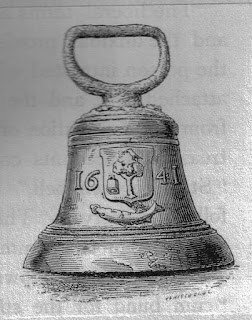Samuel
Wolcott’s heart was stirred, probably not for the first time, but this time the
emotion spurred something like a seed that had been planted for some time to
burst through the soil as if fertilized with an extra potent Miracle Grow. Samuel
read some words that evening in 1869 in a church in Cleveland (see it here) that
struck him in a new way, moving his spirit to say “Christ for the World We Sing”,
perhaps as a pledge he couldn’t hold back. Maybe he was thinking about his
experience one-quarter century before, or was it the accumulated chapters of
his ministry since that point that roused him so? He’d been in many places,
seen many faces, and must have thought there were some common themes, or maybe there
was one overarching theme, in all the venues where he’d served. Let’s see what was
on the mind of this 56-year old fellow.
Samuel
Wolcott started out to be a missionary in a foreign land once, and maybe that’s
still what he’d like to have called himself by the time he wrote “Christ for
the World We Sing”. It was one of the
very first hymns he wrote, so knowing what spawned it is tells us something
about its author. He wasn’t a guy bent on being a songwriter, this pastor who
was already well past mid-life and had been in ministry already over two
decades. Educated at Yale and Andover, his intent upon attaining his degree by
his mid-20s must have been mission work, which he pursued in Syria between 1840
and 1842, before he turned 30. Apparently poor health forced his return to the
U.S., where he spent the next 25 years ministering in four different states
from the east coast to the Midwest, finding himself in Ohio where he would
later still be involved with mission work via the Ohio Home Missionary Society.
Domestic mission work was his calling one evening, as he attended a YMCA (Young
Men’s Christian Association) meeting at the Plymouth Church in Cleveland. The
banner that caught his attention said “Christ for the World, and the World for
Christ”, an objective that resonated in his heart for sure. His own account of
the incident says he wrote the words to the song on his way home from that
meeting, a stimulus with a result perhaps unlike any he’d sensed before. It’s
said that over the remainder of his life, until his death in 1886, he wrote a
total of some 200 hymns, indicating he was composing more than 10 per year
after this incident. He had a lot to say, evidently, and his missionary zeal
still burned, perhaps as he considered his life’s 25-30 years in ministry and
what he wanted to still accomplish. How would he do that, he must have
pondered. Maybe it was songwriting to which he turned, as a new method to focus
his efforts and influence the ‘world’ in which he lived.
What can
we say Samuel Wolcott did over the succeeding 17 years after expressing his
heart’s longing about Christ and the world? If we presume his words were a
pledge and encouragement to others, he did the following: he loved, prayed for,
promoted unity, and rejoiced in his efforts (vv. 1-4). That’s how he thought to
bring the world to Christ. It sounds like a winner, especially the positive
vibes it would communicate to those on the receiving end. Who can resist
feeling love and joy, having a purpose in common with others, and knowing others
genuinely pray for your well-being? What other formula works, if this one doesn’t?
The
following website has a soundtrack, all four original verses, and the brief
account of the song’s development: http://www.hymntime.com/tch/htm/c/f/t/cftworld.htm
See more
information on the song discussed above in these sources: The Complete
Book of Hymns – Inspiring Stories About 600 Hymns and Praise Songs by
William J. Petersen and Ardythe Petersen, Tyndale House Publishers, 2006; and Amazing
Grace: 366 Inspiring Hymn Stories for Daily Devotions by Kenneth W. Osbeck,
Kregel Publications, 1990.





